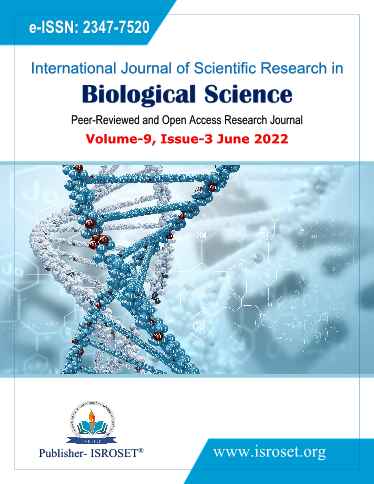Impact of Oocytes with Morphological Abnormalities on Blastocyst Formation Rate
Keywords:
oocyte abnormalities, ICSI, Blastocyst rate, intracytoplasmic sperm injectionAbstract
Objective: Aim of the study is to evaluate the intracytoplasmic and extracytoplasmic abnormalities of the human oocytes and their influence on potential embryo development and blastocyst formation rate outcome. Exclusive criteria: Cycles from cryopreserved oocytes and the patient underwent agonist stimulation protocol were excluded, Severe male factor infertility (oligozoospermia<10 million/ml)Oocyte morphology was evaluated at the time of ICSI and scored according to the scoring system described by Martin-Wilding et al. The inseminated oocytes were cultured according to standard protocol. Fertilization was assessed at 17-18 hours and cleavage was assessed at 26 hours after insemination respectively. Embryo grading was done on day 5 using Gardner’s embryo grading system. Material and Methods: A Single center, prospective observational study with patients undergoing intracytoplasmic sperm injection (ICSI) treatment between September 2020 to January 2021 was included. Oocytes are graded according to their maturity for all oocytes and subsequently assessed for fertilization, cleavage, and blastocyst grading. Correlation between oocyte morphology and fertilization rate, cleavage rate, and blastocyst rate assessed using appropriate statistical method using (SPSS) version 16.0. Result: A total of 50 patients and oocytes were studied, in that 371 oocytes underwent intracytoplasmic sperm injection (ICSI) with fertilization rate 78.4 %(291/371), cleavage rate 81%(236/291), and blastocyst rate 66.5%(157/236). Embryo grades were A-37.5%, B-50.9 %, and C-11.% oocyte morphology was not predictive of fertilization, cleavage, and blastocyst rates. Conclusion: There is no statically difference between blastocyst formation rate between morphologically normal oocytes and oocytes with morphological abnormalities like CLGC, SER, and Refractile body.
References
Laurent Janny, Yves J.R.Menezo, “Maternal age effect on early human embryonic development and blastocyst formation”, Molecular reproduction and development, Vol.45, Issue.1,pp 31-37, September 1996
P F Serhal, D M Ranieri, A Kinis, S Marchant, M Davies, I M Khadum, “ Oocyte morphology Predicts outcome of intracytoplasmic sperm injection”, Human Reproduction, Vol.12, Issue.6,PP 1267-1270, 1 June 1997
S.Kahraman, K.Yakin, E. Donmez, H. Samli, M. Bahce, G.Cengiz, S.Sertyel, M.Samli,N.Imirzalioglu, “ Relationship between granular cytoplasm of oocyte and pregnancy outcome following intracytoplasmic sperm injection”, Human Reproduction, Vol.15, Issue.11,PP 1267-1270, November 2000
Basak Balaban, Bulent Urman,” Effect of oocyte morphology on embryo development and implantation”, Reproductive BioMedicine Online, Vol.12, Issue.5, PP 608-615, 2006.
Thomas Ebnar,Marianne Moser, Gernot Tews,” Is oocyte morphology prognostic of embryo developmental potential after ICSI?”, Reproductive BioMedicine Online, Vol.12, Issue.4, PP 507-512, 2006.
Giovana D Catandi, Lance Lipuma,” oocyte metabolic function, lipid composition, and development potential are altered by diet in older mares”, society for reproduction and fertility, Vol.163, Issue.4, PP 183-198, 24 Feb 2022
Martin wilding, Loredana Di Matteo, Sonia D Andretti, Nadia Montanaro, Clemente Capobianco& brian dale,” An oocyte score for use in assisted reproduction”, Journal of Assisted Reproduction and Genetics, 24,pp 350-358(2007).
T Eber, M Moser, O Shebl, M Sommergruber, C Yaman, G Tews, “ Blood clots in the cumulus-oocyte complex predict poor oocyte quality and post-fertilization development” Reproduction BioMedicine Online Vol.16, Issue.6,PP 801-807,2008
Laura Rienzi, Gabor Vajta, Filippo ubaldi, “Predictive value of oocyte morphology in human IVF: a systematic review of the literature”, Human reproduction, vol.17. Issue.1,PP 34-45, Jan-Feb 2011.
Mojdeh Salehnia, Saeed Zavareh, “The Effects of Progesterone on oocyte Maturation and Embryo Development”, International Journal of Fertility & Sterility, Vol.7(2):74-81 Jul-Sep 2013.
Daniela paes Almeida Ferreira Braga D.V.M.,” Influence of oocyte dysmorphisms on blastocyst formation and quality”, Fertility and Sterility, Vol.100, Issue 3, September 2013, PP 748-754.
Wei Shi, Bo Xu, Li-Min Wu, Ren-Tao Jin,” Oocytes with a Dark zona pellucid Demonstrate Lower Fertilization, Implantation and Clinical Pregnancy Rates in IVF/ICSI Cycles”, PLOS ONE, Feb 24, 2014,
Lazzaroni-Tealdi, E., Barad, D. H., Albertini, D. F., Yu, Y., Kushnir, V. A., Russell, H., Wu, Y. G., &Gleicher, N. (2015). Oocyte Scoring Enhances Embryo-Scoring in Predicting Pregnancy Chances with IVF Where It Counts Most. PloS one, 10(12), 2 December 2015.
Binarwan Halim, Hilma Putri Lubis, Diana Novia,”Does oval oocyte have an impact on embryo development development in in vitro fertilization?”, JBRAAssist Reprod v.21(1), pp15-18, Jan-mar 2017
Yvonne O Brien, Mary Wingfield& Lynne C. OShea,” Anti-Mullerian hormone and progesterone levels in human follicular fluid are predictors of embryonic development” Reproduction Biology and Endocrinology, 17,47, 2019.
Downloads
Published
How to Cite
Issue
Section
License

This work is licensed under a Creative Commons Attribution 4.0 International License.
Authors contributing to this journal agree to publish their articles under the Creative Commons Attribution 4.0 International License, allowing third parties to share their work (copy, distribute, transmit) and to adapt it, under the condition that the authors are given credit and that in the event of reuse or distribution, the terms of this license are made clear.







